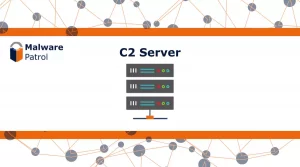 What Is a C2 Server?
What Is a C2 Server?
A command and control (C2) server is a centralized system used by cybercriminals to manage and control compromised devices within a network. It acts as the operational hub for malware, sending commands to infected machines and receiving stolen data. C2 servers enable attackers to execute a variety of malicious activities.
By maintaining communication with compromised devices, C2 servers play a critical role in the persistence and effectiveness of cyber threats:
1. Remote Control and Management
C2 servers provide attackers with the ability to remotely control compromised devices. This includes executing commands, initiating processes, and managing infected systems from a central location. By sending instructions through the C2 server, attackers can maintain persistent control over their malware operations.
2. Downloading Additional Malware Payloads
One of the primary functions of a C2 server is to facilitate the download of additional malware onto compromised devices. This can include:
- Trojans: Used to create backdoors for future access.
- Keyloggers: To capture and transmit keystrokes, allowing attackers to steal credentials.
- Rootkits: To hide the presence of malware and maintain persistent access.
- Spyware: To monitor user activity and exfiltrate sensitive information.
- Ransomware: Encrypts files on the victim’s system and demands a ransom for the decryption key.
3. Exfiltration of Data
C2 servers are often used to exfiltrate data from compromised systems. This data can include:
- Personal Identifiable Information (PII): Such as names, addresses, Social Security numbers, etc.
- Financial Information: Credit card details, bank account information, etc.
- Intellectual Property: Confidential business information, proprietary technologies, etc.
- Credentials: Usernames and passwords for various services.
4. Issuing Commands to Botnets
Botnets, networks of malware-infected devices controlled by a C2 server, are used for various malicious activities:
- Distributed Denial of Service (DDoS) Attacks: Flooding a target with traffic to overwhelm and disrupt its services.
- Spamming: Sending large volumes of unsolicited emails to promote scams or distribute malware.
- Click Fraud: Generating fraudulent clicks on ads to generate revenue.
- Mining Cryptocurrencies: Using the processing power of infected devices to mine cryptocurrencies.
5. Downloading and Executing Ransomware Encryption Keys
For ransomware operations, C2 servers play a critical role in:
- Downloading Encryption Keys: Once ransomware is deployed, the malware contacts the C2 server to download encryption keys necessary to encrypt the victim’s files.
- Transmitting Decryption Keys: If the victim pays the ransom, the C2 server may provide a decryption key to restore access to the encrypted data.
6. Monitoring and Managing Infected Systems
C2 servers enable attackers to monitor the status of infected systems and manage their operations. This includes:
- Gathering Information: Collecting data on the infected environment to plan further attacks.
- Updating Malware: Pushing updates to existing malware to enhance its capabilities or fix bugs.
- Removing Traces: Issuing commands to remove traces of the malware to avoid detection.
7. Establishing Persistence
C2 servers help in establishing persistence on infected systems by:
- Deploying Rootkits: To hide the presence of malware from detection tools.
- Setting up Backdoors: Creating backdoors to ensure attackers can regain access even if the initial infection vector is closed.
8. Coordinating Sophisticated Attacks
C2 servers are used to coordinate complex, multi-stage attacks:
- Advanced Persistent Threats (APTs): Long-term targeted attacks aimed at stealing data or disrupting operations.
- Watering Hole Attacks: Compromising websites frequently visited by the target to deliver malware.
- Supply Chain Attacks: Infiltrating less secure elements of a supply chain to compromise more secure targets.
How to Manage Threats from C2 Servers
Protecting against and hunting for C2 (Command and Control) traffic involves a combination of proactive defense measures, continuous monitoring, and advanced threat detection techniques. Here’s a detailed guide on how companies can effectively manage these tasks:
1. Network Traffic Analysis
Deep Packet Inspection (DPI)
- Functionality: DPI involves examining the data part (and possibly also the header) of packets as they pass through an inspection point. It looks for protocol anomalies, malicious payloads, and specific data strings.
- Implementation: Use DPI-capable firewalls and intrusion detection/prevention systems (IDS/IPS).
Anomaly Detection
- Functionality: This method involves establishing a baseline of normal network behavior and then detecting deviations from this norm.
- Implementation: Employ machine learning algorithms and behavioral analysis tools to identify unusual traffic patterns that may indicate C2 communication.
2. Endpoint Protection
Endpoint Detection and Response (EDR)
- Functionality: EDR tools continuously monitor and collect data from endpoints to detect suspicious activities and facilitate immediate response.
- Implementation: Deploy EDR solutions that can detect malware behavior, track C2 connections, and automatically isolate compromised endpoints.
Anti-malware and Antivirus
- Functionality: Traditional antivirus and anti-malware solutions use signature-based detection to identify known threats.
- Implementation: Regularly update antivirus definitions and use heuristic analysis to detect new and unknown malware strains.
3. Threat Intelligence Integration
Threat Intelligence Feeds
- Functionality: Threat intelligence feeds provide up-to-date information on known C2 server addresses, IPs, domains, and other IOCs (Indicators of Compromise).
- Implementation: Integrate threat intelligence feeds into security information and event management (SIEM) systems to automatically block or flag communications with known malicious C2 servers.
Collaborative Threat Sharing
- Functionality: Sharing threat intelligence within industry groups and with public-private partnerships enhances the overall security posture.
- Implementation: Participate in information sharing and analysis centers (ISACs) and use platforms like STIX/TAXII for automated threat intelligence sharing.
4. Network Segmentation and Isolation
Network Segmentation
- Functionality: Dividing a network into segments limits the spread of malware and restricts C2 communication within isolated sections.
- Implementation: Implement VLANs, firewalls, and access control lists (ACLs) to enforce strict segmentation.
Isolation of Critical Assets
- Functionality: Isolating critical systems from the rest of the network reduces the risk of C2-based attacks impacting vital operations.
- Implementation: Use dedicated, physically isolated networks for critical infrastructure and apply stringent access controls.
5. DNS Filtering and Analysis
DNS Sinkholing
- Functionality: Redirecting malicious domain name system (DNS) queries to a controlled environment to prevent communication with C2 servers.
- Implementation: Configure DNS sinkholes to intercept and analyze queries to known malicious domains.
DNS Traffic Monitoring
- Functionality: Monitoring DNS traffic for unusual patterns that may indicate C2 activity, such as frequent or irregular DNS requests.
- Implementation: Use DNS security solutions and logs to detect and investigate suspicious DNS queries.
6. Email Security
Email Filtering
- Functionality: Filtering email to block phishing attempts and malware delivery vectors.
- Implementation: Employ advanced email security solutions that use spam filters, attachment scanning, and URL analysis.
Phishing Awareness Training
- Functionality: Educating employees about phishing and social engineering tactics reduces the risk of initial malware infection.
- Implementation: Conduct regular training sessions and simulated phishing exercises to enhance awareness.
7. Log Analysis and SIEM
Centralized Log Management
- Functionality: Collecting and analyzing logs from various network devices, endpoints, and applications to detect signs of C2 traffic.
- Implementation: Use a centralized log management solution and SIEM to correlate and analyze security events.
Automated Incident Response
- Functionality: Automating responses to detected threats to quickly mitigate C2-related incidents.
- Implementation: Configure SIEM and EDR tools to automatically block suspicious IPs, isolate infected systems, and alert security teams.
8. Advanced Analytics and Machine Learning
Behavioral Analytics
- Functionality: Using machine learning to model normal behavior and detect anomalies indicative of C2 activity.
- Implementation: Deploy behavioral analytics tools that continuously learn and adapt to new threats.
User and Entity Behavior Analytics (UEBA)
- Functionality: Monitoring the behavior of users and devices to identify deviations that may indicate compromise.
- Implementation: Integrate UEBA solutions with SIEM for enhanced detection capabilities.
9. Regular Threat Hunting
Proactive Threat Hunting
- Functionality: Actively searching for signs of C2 activity within the network before automated systems detect them.
- Implementation: Employ dedicated threat hunting teams to perform regular searches based on the latest threat intelligence and behavioral indicators.
Conclusion
To effectively protect against and hunt for C2 traffic, companies must employ a multi-layered defense strategy. Continuous monitoring and proactive defense measures, combined with a thorough understanding of C2 mechanisms, enable companies to maintain robust cybersecurity and effectively safeguard against sophisticated cyber threats.
How Can Malware Patrol Help?
Malware Patrol offers a wide variety of threat intelligence feeds for use within organizations of all sizes and industries. We verify our feeds constantly – every hour in most cases – to ensure they contain only actionable indicators that protect our customers against malware infections and data breaches.
For ease of use, we format the feeds for compatibility with the most popular security tools and platforms. To learn more or to request a free evaluation, you can contact us and our cybersecurity experts will get in touch with you.
